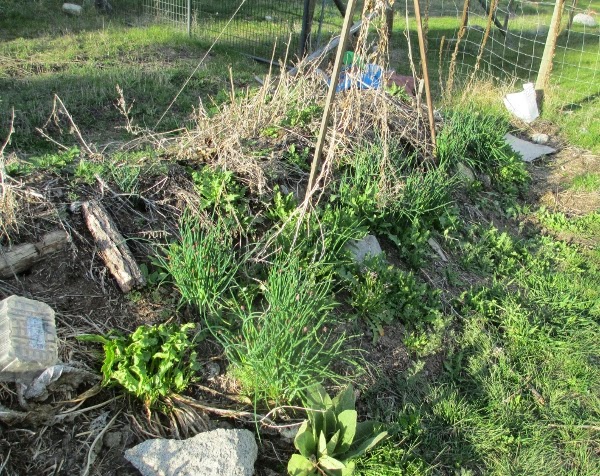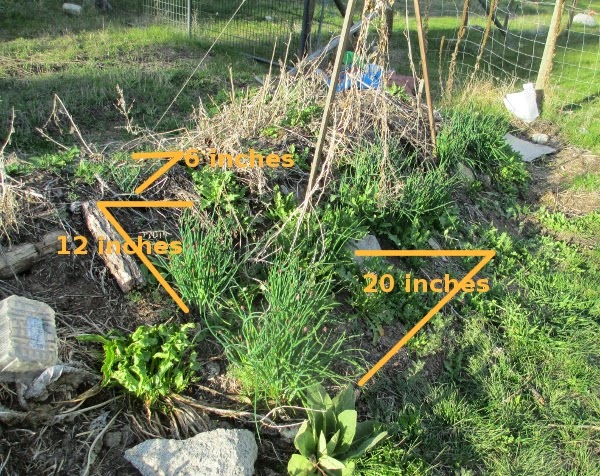We're also in a dry, montane climate (Okanogan Highlands, 3200 feet elevation).
I put in one modest hugel two years ago (maybe 2 or 3 feet pile of logs, 20-30 feet long, plus dirt and mulch). I liked the performance, so this spring I did a large 'huglacier' (3' x 6' trapezoidal pile of snow and wood, maybe 8' to 12' wide between two dirt piles, beside our driveway retaining wall). Both are holding more moisture than the natural soil here, which is an expansive silt that tends to crust up and block water infiltration when dry, and drains water downward relatively quickly when damp.
There are several schools of thought on hugel beds.
One is to build very large beds (6 feet height / depth of wood or more), to retain winter moisture through the summer. These should theoretically never need irrigation, but the ones I've seen actually live up to this promise have been in areas like Michegan where they have summer rain and humidity, not the arid West. there may be western ones working great; it's just far easier to grow Eurasian garden annuals in climates with more summer moisture to begin with.
Another theory is to build whatever size bed you can manage (larger gives more effect), and use the heights and orientations of those beds as micro-climates. You can treat the top as a 'sacrifice zone' which effectively receives much less than your annual rainfall. The slope of the bed, and the retained moisture in the logs, means that your most useful enhanced growing zone is the feet of the bed.
Check out this shot from a few weeks ago here, for example:

You can see from this picture of my green onions that over-wintered the difference in height between those at the top and the bottom of the bed.
Here's the heights highlighted:

You can see the huge difference between the growth at the bottom of the slope, and along the top. We lost most of the plants that I put in directly on the top - the exception was one seaberry bush that I planted by burying the root deep down into the hugel bed in a column of soil between the logs. It survived and is doing pretty good this year, comparable to the ones getting irrigated bi-weekly in a nearby conventional garden.
For a bed this size, I'm not realistically expecting it to hold moisture all summer (2-3 months of drought).
It has been doing wonderfully to create beautiful soil, especially where I have adequate mulch. Our summer heat burns organic mulch pretty fast if you keep it watered, but dessicates it without. Then it goes frozen for 4-6 months, so it's a real roller-coaster for trying to grow tender annual plants.
What I am hoping for from these beds is to combine natural micro climates and water-storage extension. This is kind of like greenhouses don't give you a trapped little slice of Florida, but they can extend the frost-free growing season by a couple of weeks either direction.
I am able to go a week to a month between waterings, compared with my in-laws' conventional mowed orchard and flat garden beds on the same property, which get a light watering about every 2 days, or at least twice each week.
I was able to maintain some level of crop last year, the 1st season for the bed, with watering roughly once a week or every 2 weeks. However, during some 2-week absences the in-laws helpfully set up a sprinkler for us, so I don't know how often there was extra water that I hadn't intended.
I'm also watching what plants grow well in different micro-climates planted on the sunny, shady, and low or high parts of the bed. Potatoes, peas, rhubarb, salad stuff seems to love the north side, which is also uphill and catches any runoff from the slope above. Tomatoes and onions, and beans that escaped our resident vole(s), did pretty well on the sunny side last year. But that side definitely dried out faster, and needs re-mulching.
The top killed several types of plants, and then got neglected; what did best on top was local weeds like lambs' quarters and wild mustards. I consider them my 'mulch crop,' providing some extra shade and shelter and organic material for building the bed over time. This spring, I let them go until I was ready to plant each part of the bed, and then uprooted or chopped them for mulch as I planted. Plus, lamb's quarters make good spanikopita.
We are looking for mulch sources, but locally it's not that affordable: I didn't buy straw at $10 per bale last year, and if I want wood chips I might have to get them from piles squirreled away by other local permies.
It looks like your bed has good mulch. Drip irrigation below that mulch, or nestled into it with some contact with the actual soil, should be a lovely and efficient way to irrigate.
In your current drought, however, is it possible to grow without irrigation? It would be a marvelous example if you can grow good food (even if it's only specific varieties) without any water, or only using greywater (recycled dishwater and shower and washing-machine water) instead of potable water.
It might be worth making some careful choices about plants, or using this year as a 'survival test' for truly hardy varieties that can live with a minimal watering schedule.
Where to irrigate if you decide to:
If you are trying to get perrennials established and then avoid irrigating in future years, then it might be worth doing two drip lines running parallel, lower down (just below midway) along the bed, to maintain the wet lower areas and leave the top as a bare / dry area. This will more realistically help the waterl-loving plants grow their roots into the places where they will naturally find water in future.
If you are trying to grow irrigation-dependent annuals with the least water use, then watering from a single line at the top seems likely to produce relatively even distribution of the least amount of water. I found with my beds that even just plugging the hose into the top of the bed somewhere, the water did find its way to the lower plantings in that part of the bed. My logs are buried lengthwise, so the wood grain presumably wicks the water along the bed as it percolates gently downward in all directions.
Hope that helps! You have inspired me to go get some current pictures, and see if I can prop up any thirsty plants with more mulch-weeding or sparing irrigation.
And it's definitely time to get my tender salad greens into some shade.
As far as climate-appropriate plants:
The onions may have started blooming a little earlier than their wild cousins, but are pretty close to the same timeline. They seem well adapted to this climate, with minimal irrigation. Strawberries grow wild here, but we water the domestic ones, and the blueberries and other small fruiting shrubs. Serviceberry (saskatoon), "Indian ice cream," elderberry, wild roses, and many other fruiting shrubs grow wild up here without irrigation.
Arugula and snow peas sometimes self-seed over winter, and onions, carrots, and parsnips have survived the winter in the ground to seed the following year. Horseradish and rhubarb (big, deep-rooted perennials) do great both in the hugel beds and in the watered gardens, and survive in the valley with little or no irrigation.
In the valley (-10 to -15 F, rather than -25 minimum temps), we have also seen lots of wonderful berries, currants, mulberry trees, and beds of strawberries and perennial herbs that come back every winter. Mediterranean herbs like oregano, thyme, sage, and rosemary if protected from frost, do great in a hugel bed or field-grown garden with little or no irrigation.
Snow peas, potatoes, carrots, radishes, lettuce and spinach and other salad greens, juicy herbs like basil and mint, and orchard trees like apple and pear do great here with irrigation. Cherries usually do great, but it's too cold for peaches or plums to be reliable commercial producers (neighbors at 1800 feet elevation have a fantastic apricot tree, however).
Corn sometimes needs a longer season, but our in-laws have grown it successfully with plenty of irrigation, some years back.
Tomatoes and beans love the summer heat, but have a short growing season at our elevation due to unpredictable early and late frosts. For peppers, melons, and squashes, I trade with a farmer further down in the valley whose growing season is about a month longer - but we have grown cucumbers and summer squashes up here successfully in the greenhouse, and some years they do OK outside as well.
The valley farmer also grows a ton of lovely flowers, including anise hyssop, pinks, sunflowers, etc. I'm angling to get some Jerusalem artichokes (sunchokes) from him to try in the top of my hugel bed, where their tubers might allow them to survive the dry conditions, and produce some shade and beanstalks for my other plants.
Hope that's helpful. So glad you joined the forums!
Yours,
Erica W






 1
1




 2
2








 1
1
















